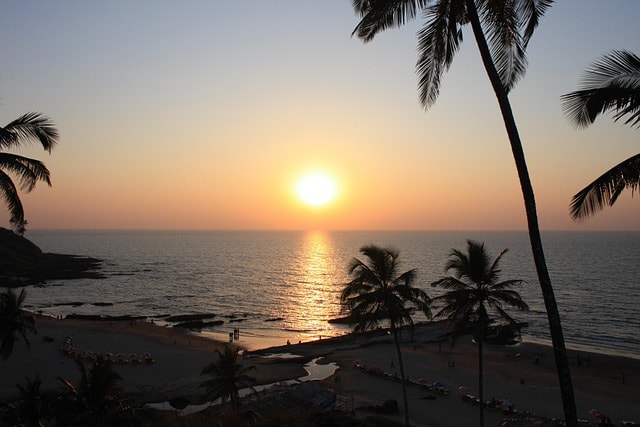Goa – Where Time Slows Down & Nights Come Alive

A Quick Throwback: Goa’s Unique History
Goa isn’t like the rest of India — and that’s not just a vibe thing. It was a Portuguese colony for 450 years, way longer than the British ruled India. That’s why the churches, houses, and even some food here have a distinct European twist.
Interesting fact: Goa only became a part of India in 1961, and many locals still speak Portuguese or a blend called Konkani-Portuguese. You’ll also find colonial-era mansions, Latin quarters (like Fontainhas), and some of the oldest churches in Asia.
And yes — it was also ground zero for the hippie trail in the 60s and 70s. That spirit? Still alive and kicking.
Why Backpackers Are Obsessed With Goa
-
Beaches. Beaches. Beaches. From party-packed to practically empty, you’ll find your kind.
-
Cheap living: Budget-friendly hostels, local food, and scooter rentals make it easy to stretch your stay.
-
Chill culture: No one cares what you wear, do, or don’t do. Come as you are.
-
Global crowd: You’ll meet travelers from everywhere — instant community.
-
Freedom: Goa feels lawless in the best way — just keep it respectful and responsible.
Must-Visit Spots in Goa
Goa has two vibes: North Goa (lively, party-central) and South Goa (laid-back, nature-heavy). Choose your side — or better yet, do both.
North Goa
-
Arambol Beach – Hippie paradise, drum circles, fire shows at night.
-
Anjuna – Home to the famous flea market and beach raves.
-
Vagator – Great for sunsets and backpacker cafes.
-
Chapora Fort – Remember Dil Chahta Hai? This is that fort.
-
Baga & Calangute – Loud, commercial, but fun if you want clubs and chaos.
South Goa
-
Palolem – Dreamy beach huts, yoga vibes, and dolphin-spotting boat rides.
-
Agonda – Peaceful and perfect for couples or solo chillers.
-
Butterfly Beach – Hidden gem, needs a boat or a short hike.
-
Cola Beach – Secluded and scenic, with a sweet little lagoon.
Hidden Gems & Offbeat Spots
-
Fontainhas (Panaji) – Goa’s colorful Portuguese neighborhood. Looks like a postcard.
-
Divar Island – Take a ferry and explore slow village life. Zero tourists.
-
Chorla Ghat – Waterfalls, wildlife, and monsoon magic up in the Western Ghats.
-
Arvalem Caves & Waterfall – Ancient rock-cut caves and a misty falls nearby.
-
Sao Jacinto Island – No tourists, just locals, mangroves, and photogenic vibes.
Stuff You Have to Try in Goa
-
Rent a scooter – ₹300 a day for the freedom to explore like a local. Wear a helmet.
-
Beach shacks – Cheap seafood, cold beer, sunset views. Don’t overthink it.
-
Psy-trance parties – North Goa still hosts some insane underground raves.
-
Cashew feni shots – Local spirit. Tastes wild. Approach with caution.
-
Water sports in Baga or Palolem – Parasailing, banana boats, jet skis — go full tourist.
-
Sunset at Cabo de Rama – One of the most underrated views in Goa.
Travel Tips for Backpackers
-
Stay:
-
Hostels: Check out The Lost Hostel, Pappi Chulo (Vagator), or Jungle by Hostelcrowd (Palolem).
-
Off-season (monsoon): You’ll get dorms as cheap as ₹200–₹300/night.
-
-
Food:
-
Eat local. Try fish thali, bebinca, and xacuti.
-
Street food is safe-ish but skip raw salads if you have a weak gut.
-
-
Transport:
-
Rent a scooter or bike. Public transport is patchy.
-
Taxis and Ubers are overpriced or non-existent in many areas.
-
-
Safety:
-
Goa is chill but still, watch your drink, especially at big parties.
-
Don’t carry drugs — Goa police are not as relaxed as the vibe.
-
When to Visit Goa
-
November – February: Peak season. Great weather, amazing parties, packed beaches.
-
March – May: Hot but manageable. Fewer crowds, lower prices.
-
June – September (Monsoon): Lush green, peaceful, fewer parties, but magical in its own way. Cheap AF.
Pro tip: If you’re here during New Year’s Eve, book everything in advance. Goa goes insane during Christmas and NYE.
One Last Thing: Let Goa Happen to You
If you try to “do Goa right,” you’ll miss the point. Goa isn’t meant to be conquered or ticked off a list. It’s meant to be felt — barefoot on the sand, dancing with strangers, biking through backroads with no plan.
Come for a few days, stay for weeks. That’s the Goa effect.
And hey, if you end up extending your trip and rescheduling your next three cities — don’t worry. We all did.
